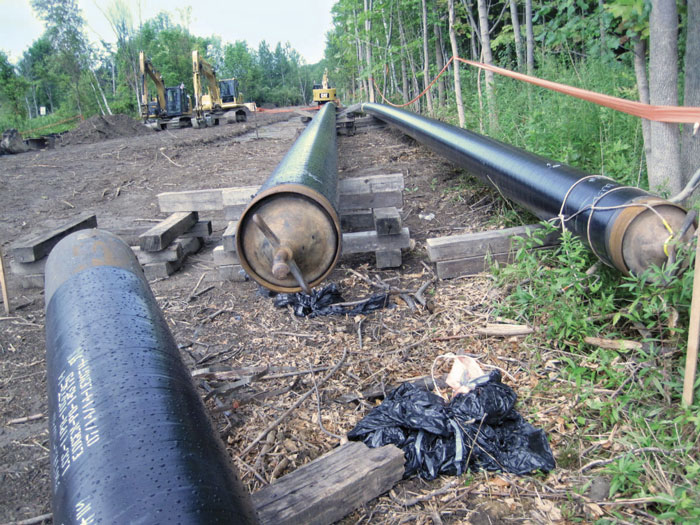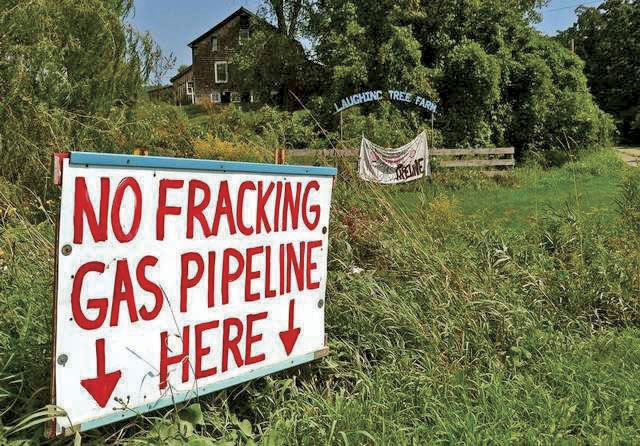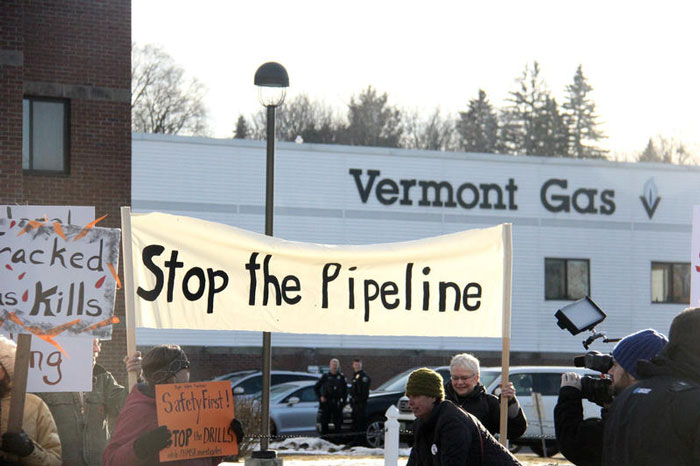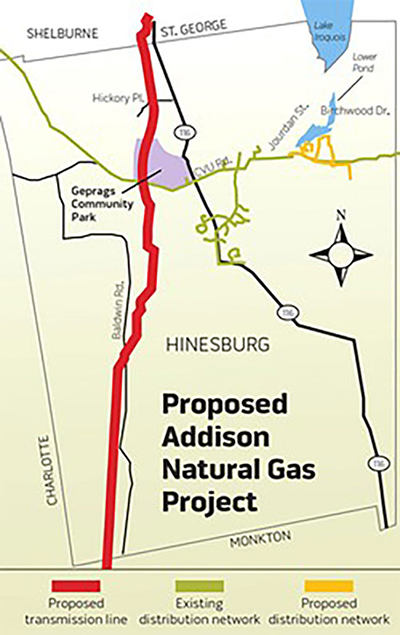| Crafting a Climate Action Agenda in Vermont | ||||||||||
| by K.C. Whiteley | ||||||||||
After the 2017 session ended, Scott appointed a 21-member Vermont Climate Action Commission (VCAC) in what has turned out to be a token gesture to address strong public support for Vermont’s renewable energy goals. The commission was charged to hold public meetings and come up with recommendations to reduce greenhouse gas emissions and combat climate change. The first red flag that this might not be a well balanced representation of interests came when Peter Walke, Scott’s deputy secretary at the Agency of Natural Resources, named Annette Smith, an influential opponent of large renewable energy projects especially wind, to head up a Technical Advisory Group to provide input and expertise to the commission. Of the 21 commission members, only one represented a statewide environmental organization. The commission carried out its charge and submitted a preliminary report to the governor in December, 2017, with five recommendations, based in part on public input: (1) support advanced wood heat; (2) increase pace of weatherization; (3) study all regulatory and market decarbonization mechanisms; (4) foster the climate economy; and (5) electrify the transportation system.It recommended an “independent, non-partisan evaluation of the full spectrum of regulatory and market-based approaches to reducing Greenhouse Gas (GHG), including carbon pricing mechanisms, carbon market opportunities, and regulatory control policies. The Commission recommends the Legislature’s Joint Fiscal Office contract that study with a well-respected, independent research organization to provide Vermonters with the information needed to make informed decisions” (Preliminary Recommendations of the Vermont Climate Action Commission, Executive Order 12-17, Submitted to Philip B. Scott, Governor, December 29, 2017). Although it was well known that Scott did not support putting a price on carbon, it came as a real surprise that he refused to back the fairly bland findings of his self-appointed commission’s recommendation that the state review and study carbon pricing strategies as a potential mechanism to decrease Vermont’s fossil fuel emissions. Despite evidence to the contrary, Scott continues to claim that a tax on carbon would hit low-income Vermonters disproportionately and put the state at a disadvantage in growing jobs. Ben Walsh of the Vermont Public Interest Research Group (VPIRG) noted, “Despite its nearly unanimous vote in support of a thorough, independent analysis of carbon pricing and other policies that could put Vermont on track to meet our climate goals, Governor Scott rejected such a study out of hand.” Picking up the commission’s recommendations, the House Committee on Natural Resources, Fish and Wildlife moved ahead with H.763, which asks the Joint Fiscal Office to research and “analyze financial impacts of reducing Vermont’s greenhouse gas emissions, including a carbon tax and a cap-and-trade program. (Mike Polhamus, VT Digger, Jan. 31, 2018). The committee voted in favor of the bill. The legislature’s Climate Solutions Caucus, led by Sen. Dick McCormack (D, Windsor) and Rep. Mary Sullivan (D, Chittenden-6-5), has also endorsed the carbon-pricing study as one of its top priorities. The House Committee on Appropriations recently approved funding to study the economic benefits of carbon pricing as part of a climate section in this year’s state budget. The study was then passed by the house and now goes to the senate for approval. Meanwhile, climate activists led by 350VT initiated a Town Meeting Day resolution campaign to take the pulse of Vermonters on their level of concern about the impacts of climate change and their commitment to renewable energy issues. Although the campaign got off to a late start last fall, signatures were gathered in time for 35 towns to entertain a ballot resolution supporting no new fossil fuel infrastructure and concrete steps to reach Vermont’s renewable energy goals (90% renewables by 2050). As reported by Jaiel Pulskamp, lead campaign organizer for 350VT, Vermonters from 35 towns voted overwhelmingly in favor of resolutions seeking climate solutions. The exact wording of the resolutions varied by town, but all evolved from the basic language recommended by 350VT to: (a) Halt any new or expanded fossil fuel infrastructure, including but not limited to energy pipelines; (b) firmly commit to at least 90 percent renewable energy for all people in Vermont by 2050, with firm interim deadlines; and (c) ensure that the transition to renewable energy is fair and equitable for all residents, with no harm to marginalized groups or rural communities. In some towns, the resolutions passed unanimously, and every resolution passed where it was on the ballot. All the resolutions acknowledged the severity of climate change, urged the State of Vermont to meet its goals for 90 percent renewable energy, and called for a fair and equitable transition off fossil fuels. In some towns, the resolutions passed unanimously, and every resolution passed where it was on the ballot. (A complete list of towns include: Arlington, Bennington, Bethel, Brattleboro, Bristol, Burlington, Calais, Cornwall, Dorset, Dummerston, East Montpelier, Greensboro, Guilford, Huntington, Lincoln, Manchester, Marlboro, Marshfield, Monkton, Montpelier, Peacham, Peru, Plainfield, Putney, Shaftsbury, Sharon, Stowe, Strafford, Thetford, Tunbridge, Wardsboro, Weston, Williston, Woodbury, and Worcester. In Montpelier, the resolution passed via Australian ballot, 1,715 to 500. In Brattleboro, the margin was even larger, 910 in favor, 180 opposed.) Tom Hughes, of Energy Independent Vermont (EIV) estimates that “wins in 35 communities (14% of the 251 towns) amounts to 23% of the Vermont population.” Maeve McBride, 350VT director, expressed excitement about the number of towns passing the resolution, especially towns that were expected to be a hard sell. “People recognize that climate change is urgent and that our political leadership is falling short on solutions,” said McBride. Vermont’s comprehensive energy plan calls for renewable sources to meet 90 percent of the state’s energy needs by 2050. “We should have a lot more renewable energy infrastructure in place right now,” said Jaiel Pulskamp, field organizer for 350VT. “So we’re falling behind.” Town Meeting Day (TMD) resolutions are sometimes written off because they are nonbinding. Historically, they have influenced policy and legislation, providing a legitimate snapshot of how voters feel about relevant topics of the day, one of our nation’s last true forums of local democracy existing today. This vote sends a clear and urgent message to legislators and state leaders that Vermonters care deeply about their environment and are willing to stand up and commit themselves to reducing dependence on fossil fuels and move toward a sustainable, renewable energy future. A number of towns used the TMD resolution to propel local actions: working with town energy committees and select boards to act on specific projects to reduce energy consumption and implement efficiency measures. Pulskamp looks forward to working with towns to help them develop action plans and take the next steps by looking into resources and grants that might be available. She envisions meeting with towns around the state, perhaps designing a road show with practical examples others can use, and targeting outreach to towns along the VGS pipeline route in Addison and Rutland counties. Impressed with the commitment of citizens around the state, Pulskamp plans to ramp up trainings for prospective activists on public speaking, educating, and building content knowledge about issues related to climate change. She looks to the coming election season to highlight climate change with candidates. With strong representation from local 350VT groups (called nodes) and a growing youth movement, prospects look good for next year.
The Vermont Gas Systems (VGS) pipeline in Addison County is ground zero for landowners fighting to stop the build-out of a fossil fuel infrastructure that would tie Vermonters to decades of increased dependence on imported fracked gas from Canada. Requesting approval through Certificates of Public Good (CPG’s) from the Public Utility Commission or PUC (formerly the Public Service Board), VGS’s incremental land grabs, or easements, are seen by many as a strategy to use the state as an energy corridor to bring Canadian gas through Vermont to ports where it can be exported to foreign countries. Rachel Smolker, codirector of Biofuelwatch and organizer with Energy Justice Network, has had her eye on the VGS pipeline, which now runs from Colchester to Middlebury, since it first arrived in her hometown of Hinesburg in 2012. She discovered the town select board and VGS had an agreement to begin construction with no public hearing. Fortunately, the hearing officer required the town to go through an approval process, giving Smolker and her neighbors a window to quickly gather signatures asking the town selectmen to postpone their vote. This turned into a much longer fight to stop the pipeline from going through Geprags Community Park, a public property given to the town, protected by a covenant restricting its use to recreation and educational purposes. Hinesburg citizens and landowners organized as Protect Geprags and challenged VGS on the grounds that neither the town nor the then Public Service Board had the right to grant an easement in opposition to the park’s protected use. The Public Service Board allowed the utility to go through the park; Protect Geprags appealed it to the Vermont Supreme Court and lost. I asked Smolker about the legal role of the PUC to protect the ratepayers, which she maintains they have not done. In fact, despite ongoing, strong public opposition to the pipeline, the PUC has voted with VGS’s requests every time. Gov. Shumlin pushed the project through despite his public stance favoring a renewable energy future. Six years later, Smolker leads a group of “intervenors” who have uncovered a myriad of safety violations and compiled a record of serious issues that put the entire pipeline at risk of failure through leaks and possible explosions. As intervenors in the case, they asked the then Public Service Board to reopen the pipelines’ CPG and not allow gas to flow pending resolution of their violation claims. In 2016, the intervenors delivered their documented evidence to the federal Pipeline Hazardous Material Safety Administration (PHMSA), which opened an investigation. Issues raised included problems with welding, with HDD, various concerns about pipe coatings (the first line of defense against corrosion), failure to comply with electrical safety protocols required when doing construction under high voltage transmission lines, and other serious concerns. Perhaps most fundamental was VGS’s persistent failure to provide comprehensive written specifications for construction to their contractors. PHMSA staff came to Vermont, questioned the DPS inspector, and issued an evaluation report. The state received a score of zero for failing to document or resolve probable violations to ensure compliance. At that time, Smolker stated, “The more we learn about it, the more it is clear that this project was very poorly constructed without meeting even the most basic minimum federal safety requirements. This casts serious doubt on the safety and integrity of the pipeline. Vermonters are now left not only to pay for the vastly escalated costs of the project which have more than doubled, but also will bear the consequences of the long term safety risks to life and property which now lie buried out of sight in our yards and through our communities. It would be unconscionable for the governor, the DPS and PSB to allow gas to flow through this pipeline given what we now know. Just look around and you will see that pipeline leaks and explosions are becoming all too common and can be devastating. Studies show that these incidents most often stem from avoidable errors during construction of new pipelines, which is precisely what we are witnessing here in Vermont. Slapping a fine is not going to protect people.” Despite the findings, the Public Service Board granted permission for VGS to proceed. By poring through hundreds of public records, it became clear there were scores of places where shoddy and hasty construction was noted by VGS inspectors. In several cases VGS had changed technical specifications in their records. Smolker adds, “Bottom line is the CPG was full of promises and much was ignored … no one was monitoring. This is how the industry works. There’s all these specs and details and it’s nearly impossible to make sure they’re met in the field. The contractors get a bonus for doing it fast. State inspectors were overwhelmed and reported they were unable to keep up.” For now, Smolker and her colleagues continue to highlight the profusion of safety issues that have come to light. “We have done multiple public record requests and discovery requests in this case, which resulted in thousands of pages of documentation, so our findings are derived from studying VGS and DPS own records and communications.” In their latest filing to the PUC, the intervenors asked to reopen the CPG and reevaluate the entire project, meaning, ensure its safety or dig it up and start over. Smolker believes the issues they have uncovered are systemic and link directly to corrosion, which is the leading cause of pipeline leaks and explosions. Her sense of urgency is based on how quickly these leaks and explosions can occur, often within a year or two. The motion now before the PUC states: “sufficient information has been provided to lead a reasonable observer to conclude that Vermont Gas Systems committed widespread, repeated and potentially catastrophic violations of critical public safety requirements of the Certificate of Public Good. It also violated an environmental protection requirement that is essential to protecting wetlands.” The filing includes seven safety violations that illustrate VGS’s and their contractors’ extensive careless construction. I asked why she thought the state would turn a blind eye to these violations and she replied that “the state had a blind eye. They had no idea.” On a positive note, based on the testimony filed, the PUC issued a request for proposals (RFP) in December 2017 for an independent expert to conduct an on-site survey of pipeline depths along a designated section in New Haven and at stream crossings along the 41-mile route. These findings will be compared to data in VGS’s self-certification. Because there are a limited number of engineering firms in the state who can do this type of work, the RFP was not awarded at the time of this interview. Smolker and her colleagues have since filed a motion to broaden the scope of the case and were awaiting the PUC’s response when we talked. She shared her experience as a citizen with thousands of hours invested in this case, with no specific background or authority, having to fund raise to pay legal costs, educate herself about the state and federal rules, and simultaneously working a full-time job. Citizen access to resources and power are limited in comparison to the state or VGS, and they are doing the work that the state should be doing to ensure the health and safety of Vermonters along the pipeline route. Meanwhile, there is a growing body of evidence of serious public safety risks that cannot be denied. A complementary effort to stop the VGS and any other new pipeline is going on at the Statehouse, where Rep. Mary Sullivan introduced H.746 to the House Committee on Energy and Technology. The bill proposes to prohibit the construction of fossil fuel infrastructure in Vermont, except for infrastructure certified by the Federal Energy Regulatory Commission. Despite a late introduction, Sullivan is positive about laying the groundwork with her committee and will reintroduce the bill next session with more cosponsors. As cochair of the Climate Solutions Caucus, Sullivan hopes the caucus will begin to “flex our muscles more” next session and focus on bills like this.
The TMD resolution provides support and incentive to legislators to take stronger positions on climate change and renewable energy. Pulskamp encourages voters in towns that passed the resolution to contact their legislators and use it as a tool for next year. She hopes to reintroduce a TMD resolution next year and double the number of towns passing it. These votes will also support the Protect Geprags work. Copies of the TMD results will be sent to the PUC. As chair of 350VT’s Advisory Board, Patrick Flood believes the TMD vote gives a good idea of how many concerned citizens there are whose points of view are not being reflected by our legislators or the governor. Flood has been active in the climate justice movement since he began to notice changes in weather patterns back in the 1990s. As an outdoorsman, he noticed more rain, less snow, and warmer temperatures. In the early 2000s, he was one of the early organizers of a climate change group that became 350, founded by Vermonter Bill McKibben. Flood remarks on progress the grassroots organization has made by being able to mobilize citizens around the state. When H.746 was introduced in late February, 350VT and other environmental groups like VPIRG activated their networks, and within a week, legislators began to get calls and e-mails from constituents urging them to support it. Like Sullivan, Flood is optimistic that this year’s groundwork will position the bill for serious consideration next session. Between now and next January is the time to educate and advocate, show up at public forums, and push candidates to commit to climate change solutions. Several of the towns that passed the TMD resolutions are already working on specific solutions that move them away from fossil fuel dependence and toward renewable energy independence.
|
||||||||||
|
K.C. Whiteley is a climate activist, 350VT Board member, and 350NOLA activist.
|
|||||||||




